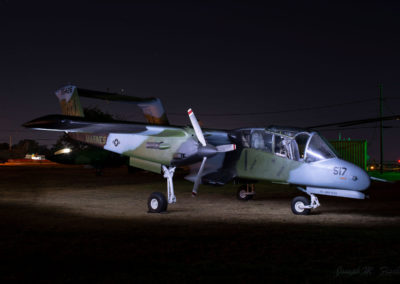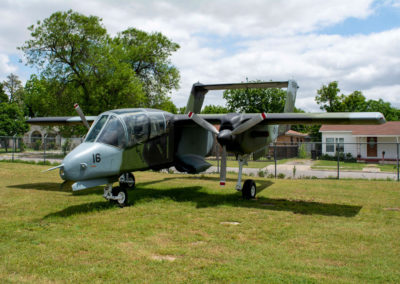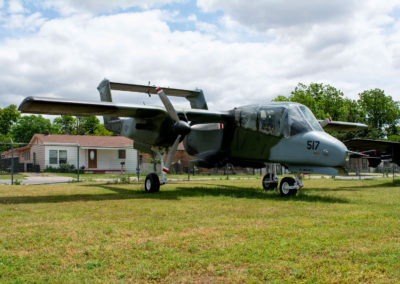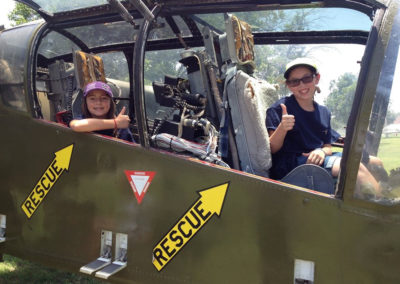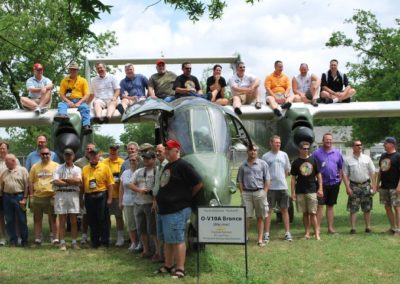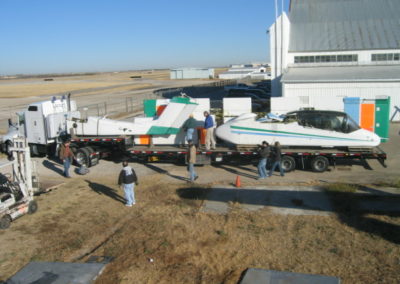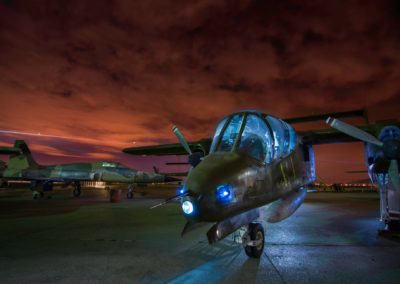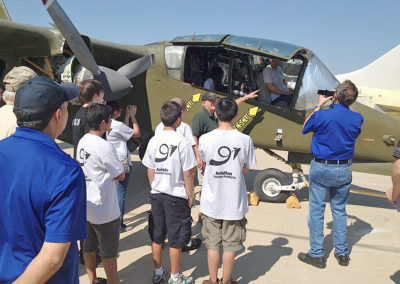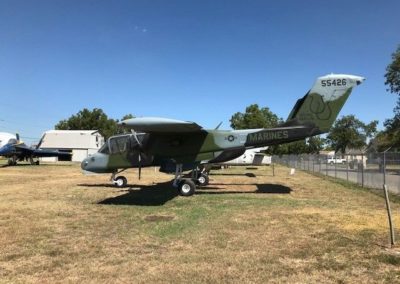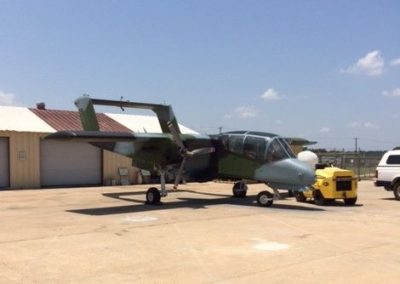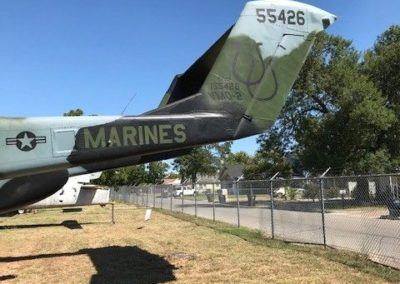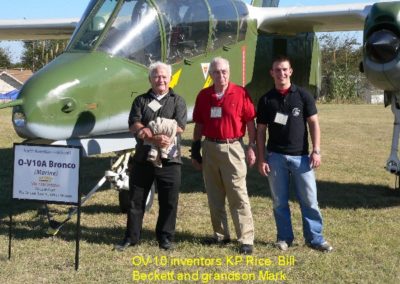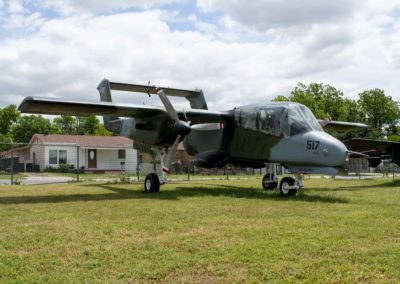OV-10A Marine Bronco
The OV-10A is a twin-turboprop short takeoff and landing aircraft conceived by the U.S. Marine Corps and developed under a U.S. Air Force, Navy and Marine Corps tri-service program for a Light Armed Reconnaissance Aircraft (LARA).
Warbird Overview
The OV-10A is a twin-turboprop short takeoff and landing aircraft conceived by the U.S. Marine Corps and developed under a U.S. Air Force, Navy and Marine Corps tri-service program for a Light Armed Reconnaissance Aircraft (LARA). The North American Rockwell aircraft first flew on July 16, 1965. The first production OV-10A was ordered in 1966, and its initial flight took place in August 1967.
ABOUT THE OV-10A BRONCO (MARINE)
This is one of three OV-10s at FWAM.
The OV-10A is a twin-turboprop short takeoff and landing aircraft conceived by the U.S. Marine Corps and developed under a U.S. Air Force, Navy and Marine Corps tri-service program for a Light Armed Reconnaissance Aircraft (LARA). The North American Rockwell aircraft first flew on July 16, 1965. The first production OV-10A was ordered in 1966, and its initial flight took place in August 1967.
The Bronco’s US military missions included observation, forward air control, helicopter escort, armed reconnaissance, gunfire spotting, utility and limited ground attack. The USAF acquired the Bronco primarily as a forward air control (FAC) aircraft. Adding to its versatility is a rear fuselage compartment with a capacity of 3,200 pounds of cargo or five combat-equipped troops or two litter patients and a medical attendant.
Another unique unit operating OV-10s was the US Navy’s Light Attack Squadron FOUR, VAL-4, “Black Ponies.” The unit was unusual in that it was ground-based. They provided fixed-wing close air support for River Patrol Boats in the Mekong Delta area of Vietnam.
On July 6, 1968, the Marines first OV-10s arrived at Marble Mountain, Vietnam, and flew its first mission that day. The first Air Force OV-10s also arrived shortly thereafter. The nearly 300 aircraft were all produced at Air Force Plant Number 85 at Port Columbus Airport in Ohio. The last one was built in 1976.
The Air Force retired their last OV-10 in 1991, but the Marines continued to operate theirs until July 1994. Foreign governments and other US Government agencies – Bureau of Land Management, Bureau of Alcohol, Tobacco, and Firearms, and the California Department of Forestry and Fire (CDF) – continued to operate OV-10s.
Fact #1
This aircraft was one of the first OV-10As built by North American Rockwell in Columbus, Ohio.
Fact #2
The Bronco was the primary FAC aircraft of the Marine Corps from 1968 through Desert Storm.
Fact #3
This particular Bronco operated for many years in Okinawa with Marine Observation Squadron Six, VMO-6. Afterward, it was transferred to the Bureau of Land Management and served in Fairbanks, Alaska, as a forest fire support aircraft, much like a FAC. When BLM ceased flight operations, the aircraft was transferred to CAL Fire in Sacramento, California, where it was acquired by Fort Worth Aviation Museum.
Manufacturer: North American Aviation
Engines: Two Garrett-AiResearch T76 turboprops of 715 shaft horsepower each
Max. Speed: 281 mph
Cruising Speed: 223 mphRange1,240 miles
Service Ceiling: 26,000 feet
Wingspan: 40 feetLength41 feet, 7 inches
Height: 15 feet, 1 inches
Weight: 14,444 pounds maximum
Armament: Four M-60C 7.62mm machine guns in the fuselage, plus 3,600 pounds of external stores. Rack-mounted armament in the Vietnam War was usually seven-shot 2.75-inch rocket pods with white phosphorus marker rounds or high-explosive rockets, or 5-inch four-shot Zuni rocket pods. Bombs, air-delivered seismic sensors (ADSIDS), Mk-6 battlefield illumination flares, and other stores were carried as well.
The Fort Worth Aviation Museum has three OV-10s – this USMC aircraft, a USAF aircraft, and the production mockup. This OV-10A Bronco, Bureau of Aeronautics No. 155426, c/n 305-66M37, was the 66th Bronco manufactured and was the 37th for the USMC. It was delivered to Marine Light Helicopter Squadron 267, HML-267, at Camp Pendleton, California, on June 28, 1968. This aircraft arrived in Vietnam on August 8, 1968, and was assigned to Marine Observation Squadron 2, VMO-2, which was a part of Marine Air Group 16, MAG-16, at MCALF Marble Mountain, Vietnam. In February 1970, it was moved to Da Nang Air Base when VMO-2 joined Marine Air Group 11, MAG-11. The aircraft spent 32 months in Vietnam and is estimated to have flown 2,500 hours in more than 1,000 missions in theater.
The aircraft was transferred to Marine Observation Squadron 6, VMO-6, at MCAS Futenma, Okinawa, Japan, as part of the VMO-2 standdown in March 1971. When VMO-6 was decommissioned in January 1977, the OV-10 was transferred to Headquarters and Maintenance Squadron 36, HMS-36, at Futenma. It returned to Camp Pendleton, California, in 1991 and served with VMO-2 as aircraft No. 16.
Following a very short assignment with Marine Helicopter Training Squadron 301, HMT-301, in 1993, the aircraft was retired from the military. The OV-10 was one of seven acquired by the U.S. Bureau of Land Management (BLM) in Boise, Idaho. It carried civilian registration N97LM and was based in Fairbanks, Alaska. In December 1999, the OV-10 was transferred to California Department of Forestry and Fire Protection (CDF). CDF never flew it and transferred the aircraft to the museum in April 2005.
Paint good with minor issues at tail boom as well. A good freshening up with wash and shine should be good. Shows really well for open cockpit and is one of the visitor’s favorite.
Note: Scheduling is always a moving target depending on weather and workload. All schedules are subject to changes.
Become a Member!
FLIGHT SIMULATOR
HOURS
Saturday: 9AM-2PM
Sunday: 11AM-3PM
